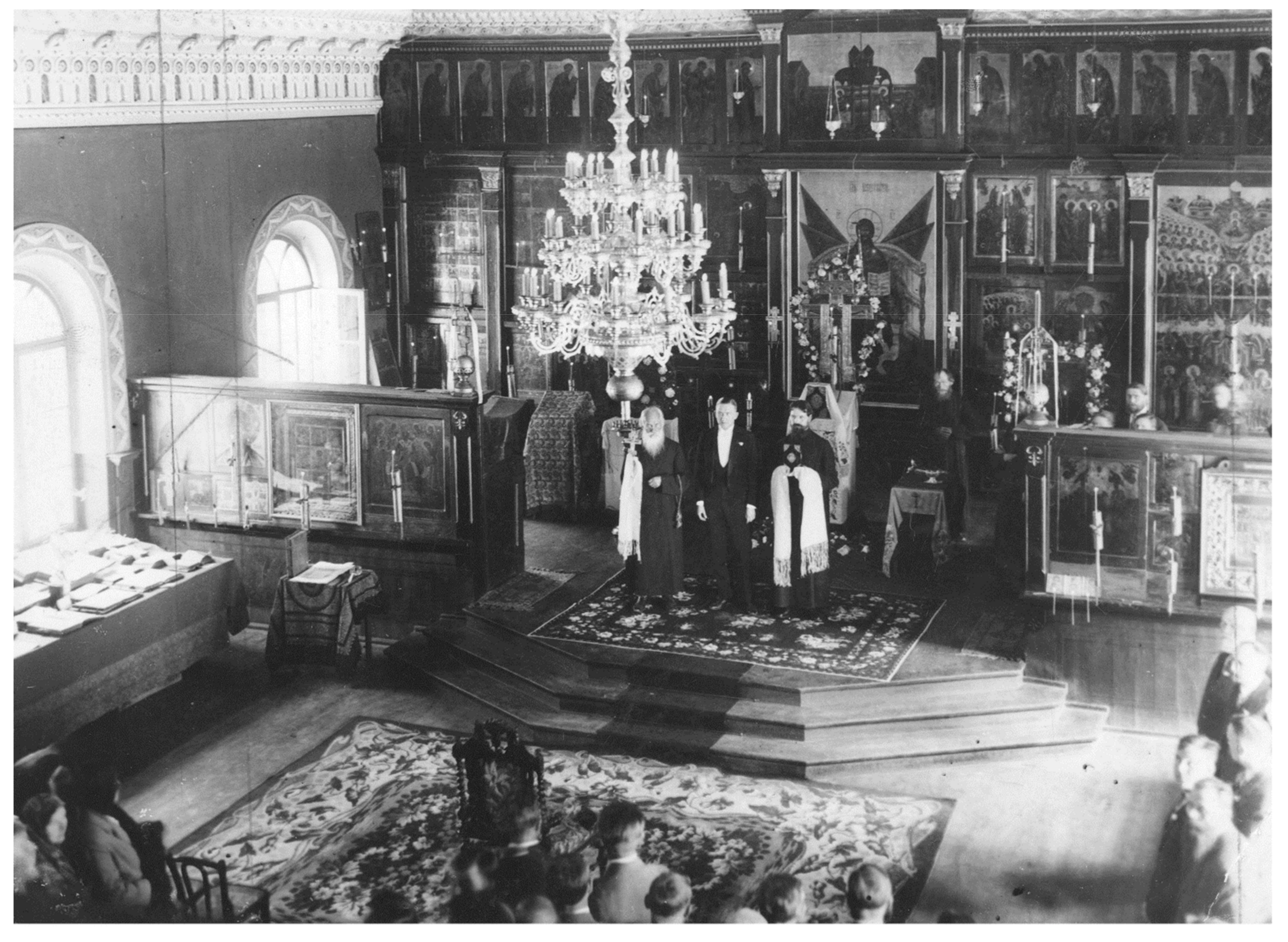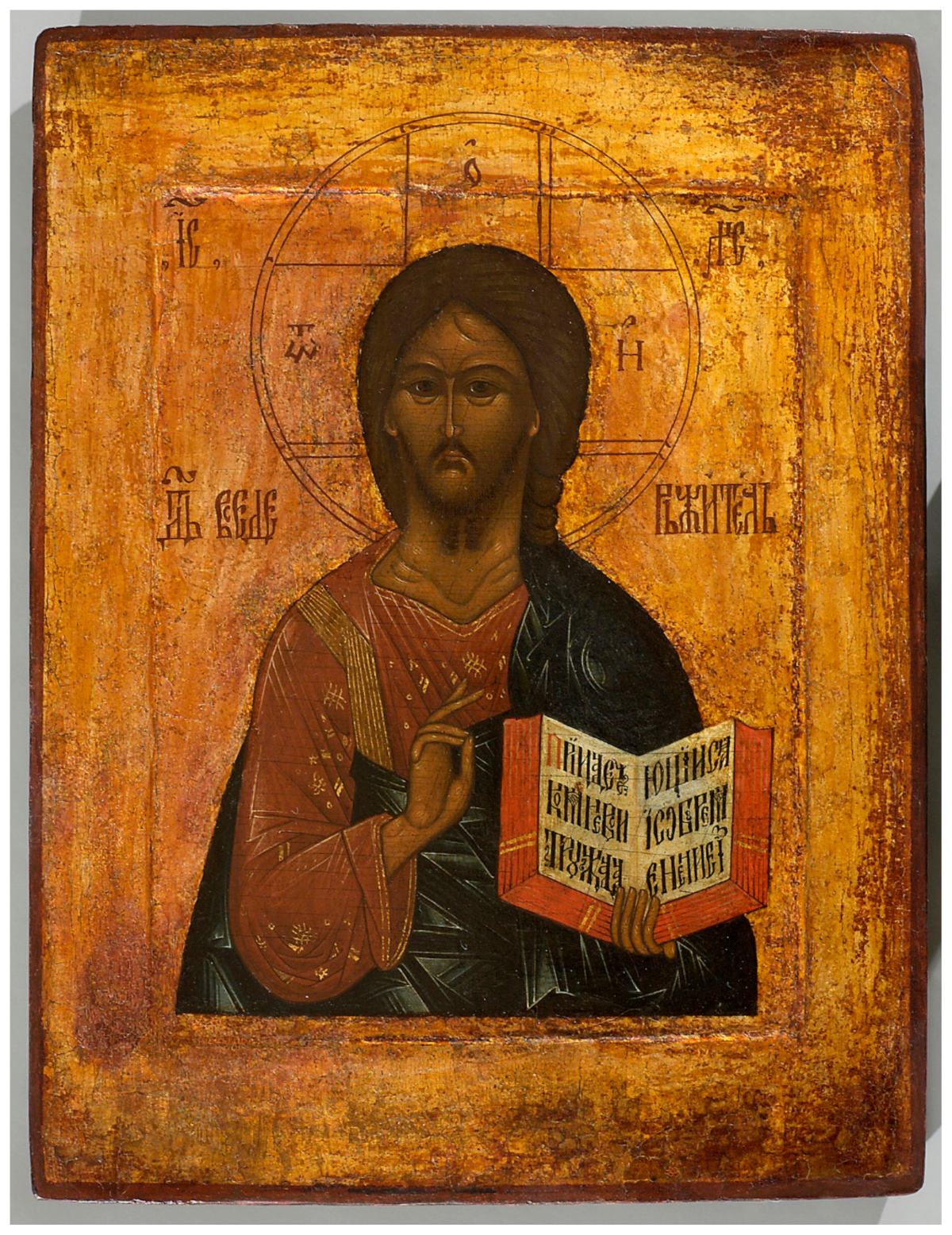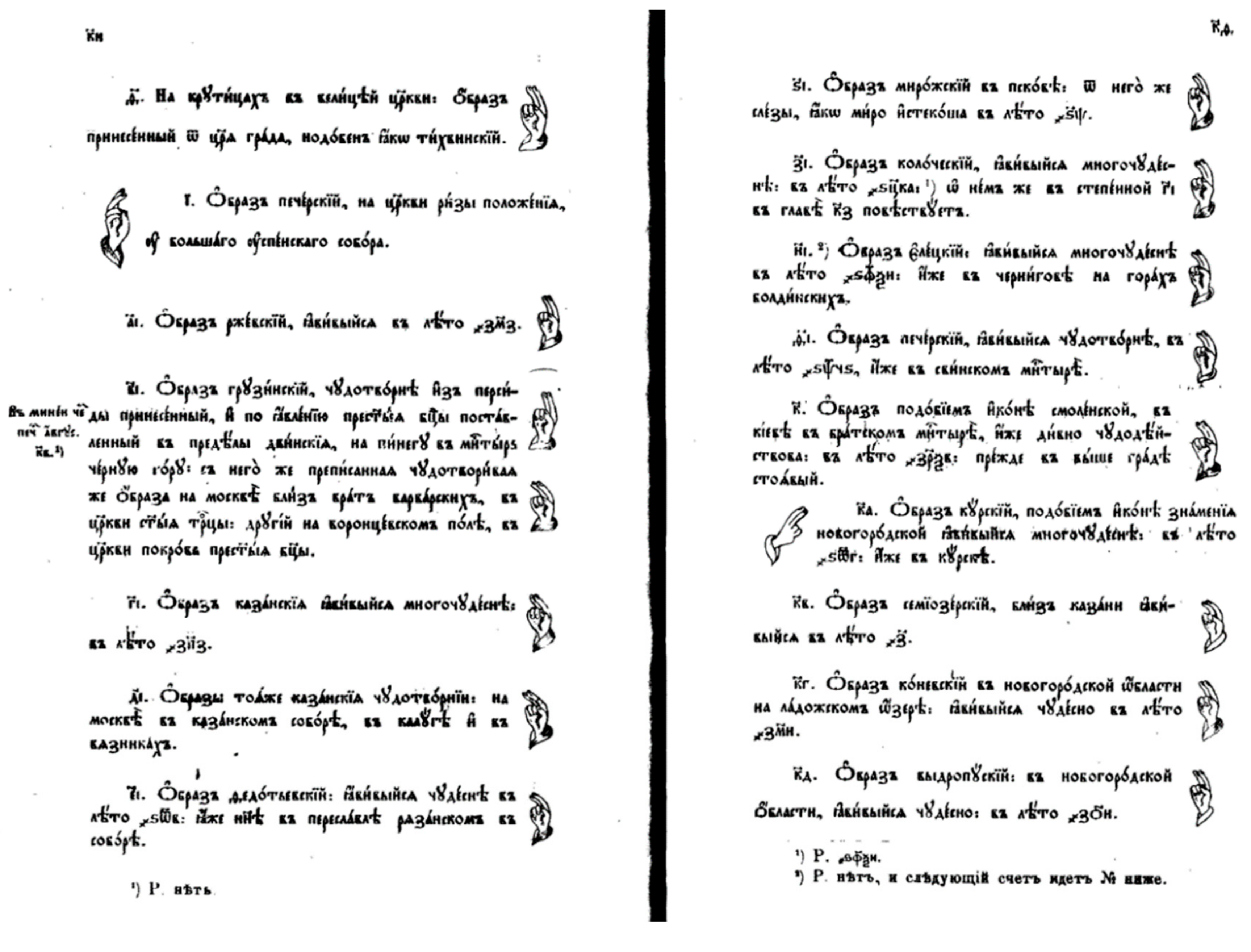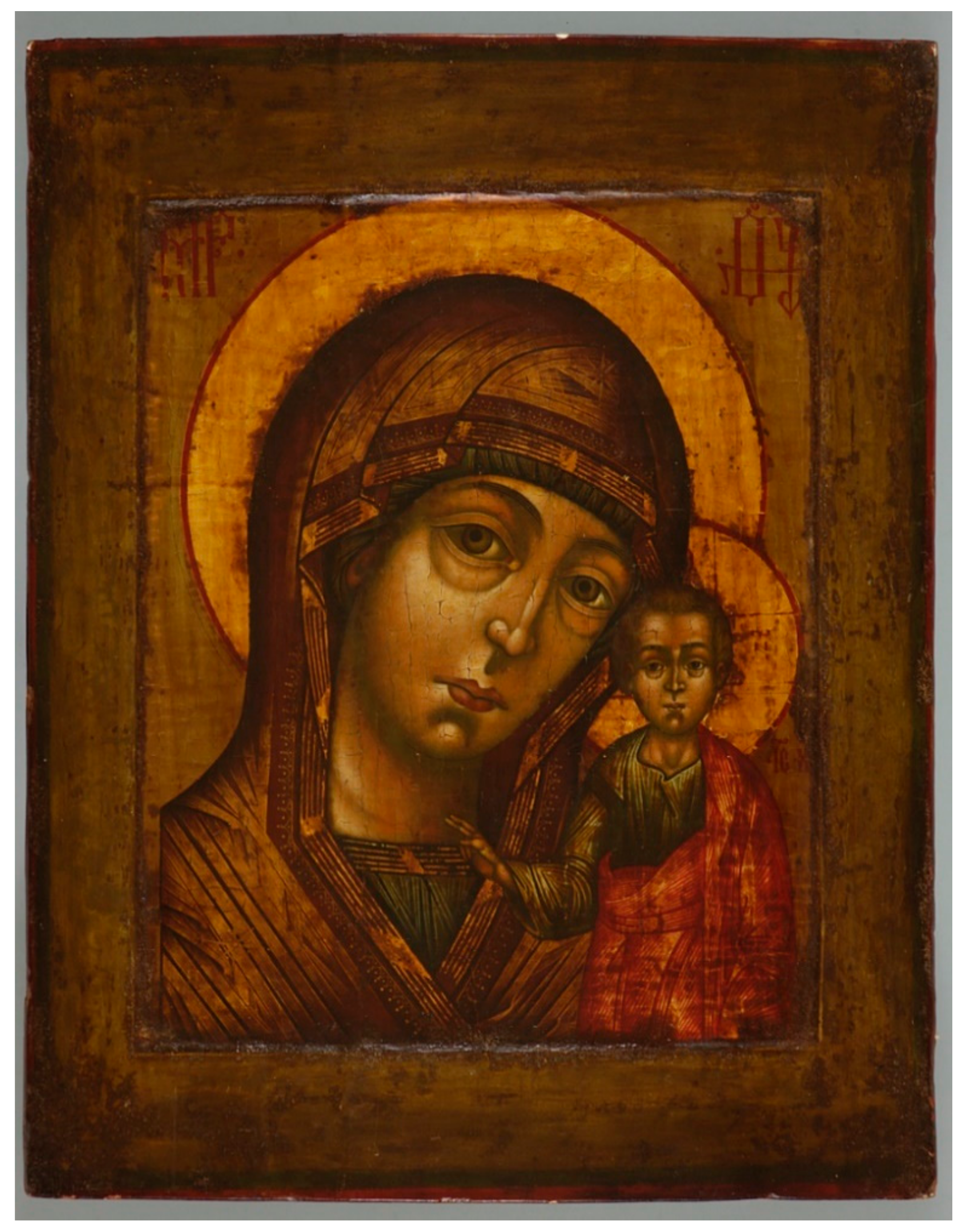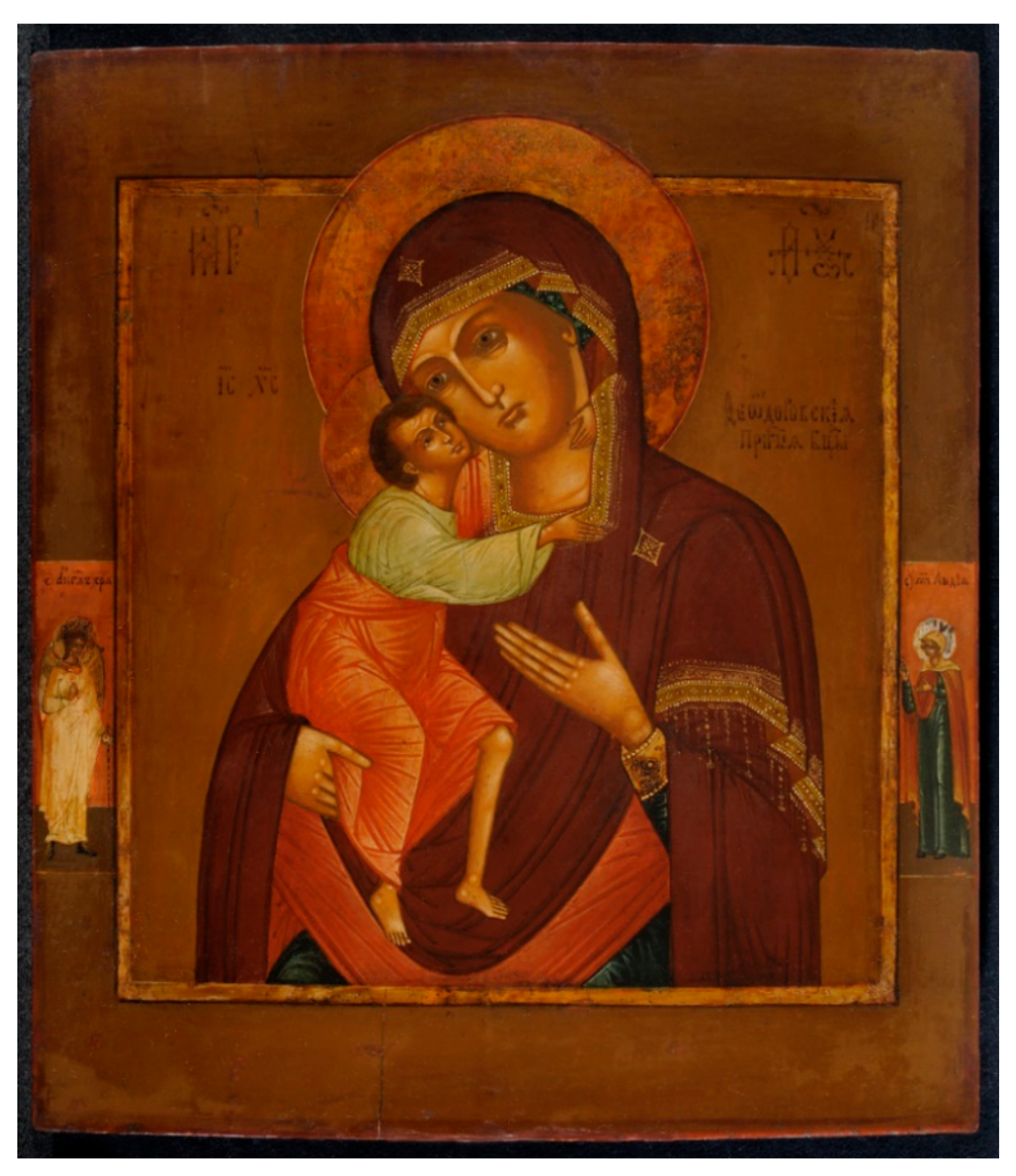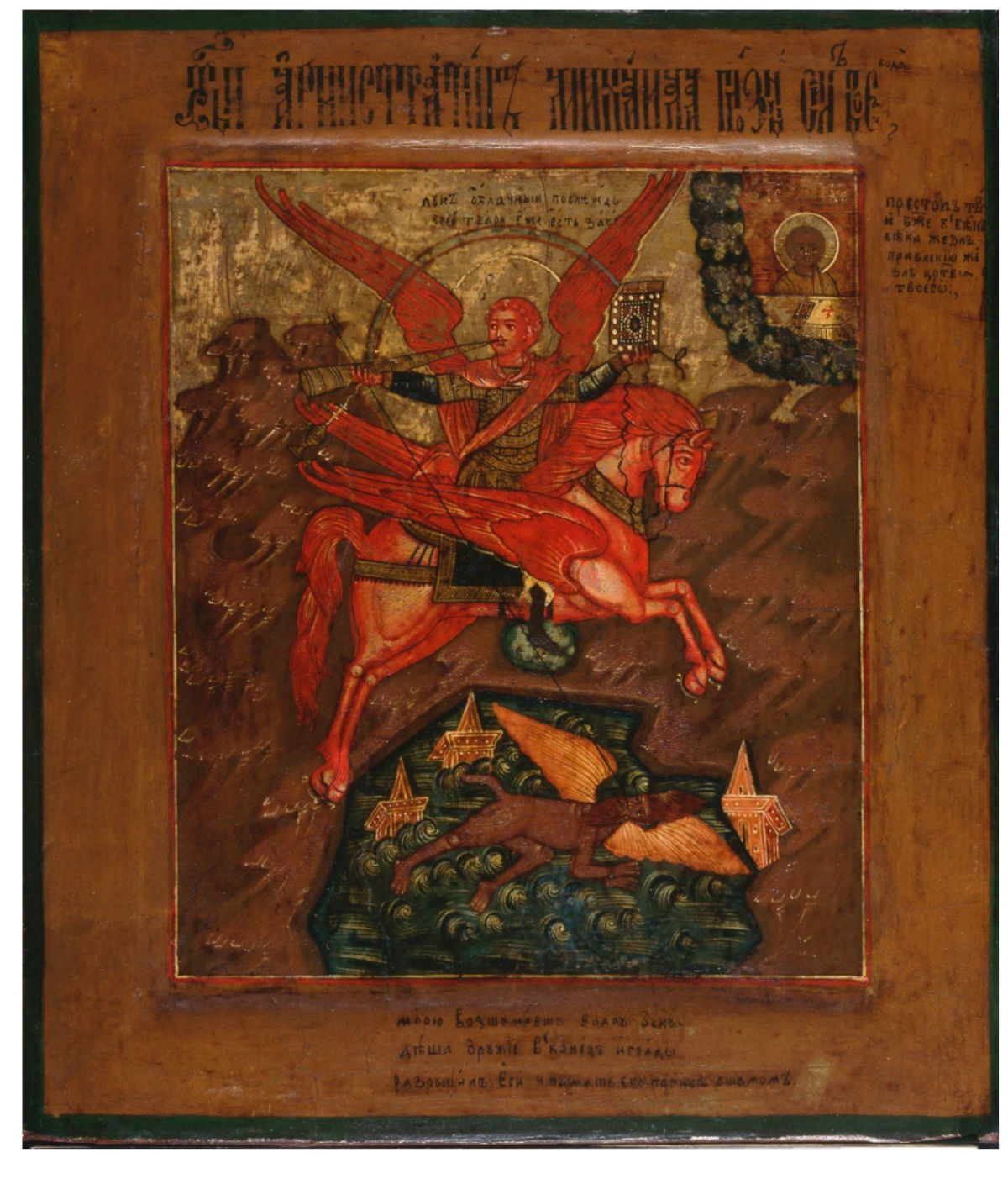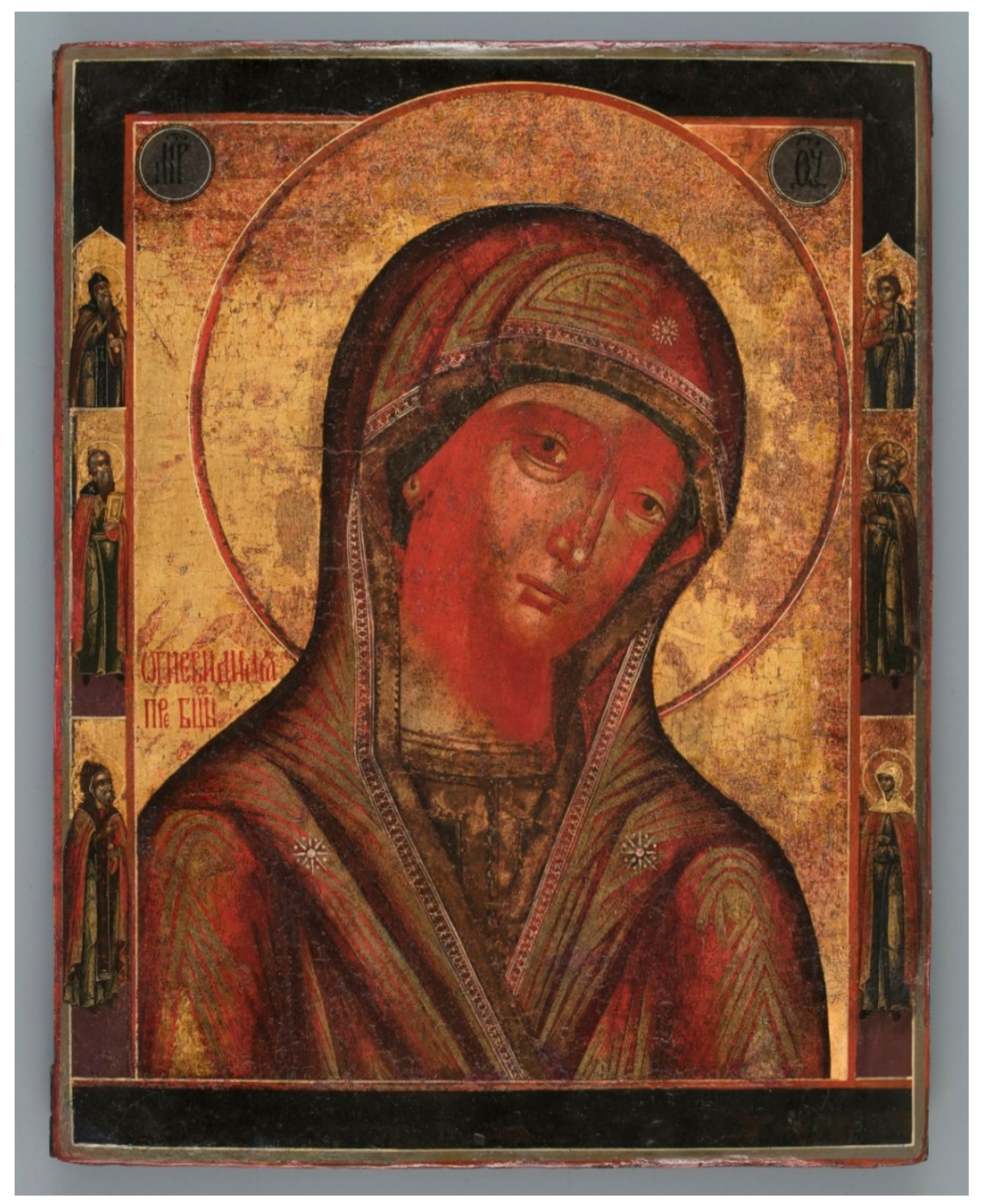1. Introduction
When I visited an Old Believers’ prayer house i.e.,
molenna for the first time I was amazed by the uncommon organization of the space. It was in 1997, in Vidzy—a village in northwestern Belarus (
Sulikowska 1998, pp. 43–45) inhabited by a multiethnic and multicultural community, a large part of which was a group of Old Believers
1. They belonged to a faction of priestless Old Believers (
bespopovtsy), thus in their prayer house there was no division into the nave and the presbytery, which is typical for the Eastern rite. Without the clergy,
bespopovtsy do not perform the Eucharistic liturgy (the liturgy of the faithful) and in their
molenna there is no altar, and no barrier separating the sanctuary from the nave. However, Old Believers used the word “the iconostasis” to denote several rows of icons that were placed on the
molenna’s eastern wall (
Iwaniec 1977, p. 150). Therefore, the iconostasis in
molenna of priestless Old Believers does not have its usual function and it does not correspond to the Orthodox Church canonical order. Icons are placed also on a so-called altar in the eastern part of the space and on the small partitions in front of it (barriers of
kliros) (
Figure 1). The Old Believers’ prayer houses, just like other Eastern churches, are always full of icons but most of them are domestic icons, i.e., icons of relatively small size and of specific iconography with a definite predominance of images of the Mother of God, Christ, and angels or saints, especially St. Nicholas the Miracle Worker. Such icons were the most popular among the Old Believers and, as a consequence, the vast majority of the objects of their worship in the contemporary museum collections are domestic icons or small-sized metalwork—icons and crosses.
Research on the Old Believers and their art has been conducted in Russia since the 19th century (
Robson 1995, pp. 3–7). Subsequently, scientific interest has expanded internationally, in particular following the publication of the English translation of Oleg Tarasov’s monograph
Icon and Devotion. Sacred Spaces in Imperial Russia (see
Tarasov 2002 for further bibliography). However, various aspects of the Old Believers’ culture, especially icons, require further research. Hitherto, the Old Believers’ domestic icons have not been discussed in detail. Roy R. Robson has shown the role of religious practices, especially of the liturgical life, prayer houses and “icons of ancient piety” in forging the Old Believers’ identity up to the beginning of the 20th century (
Robson 1993, pp. 713–24;
Robson 1995, p. 127). The purpose of this paper is to describe the status and the function of those “icons of the ancient piety”, most of which were the domestic icons in Old Believer communities, and to highlight the reasons for their unique status, from the mid-17th to the mid-18th century. I will also raise a question concerning the reasons for their predominance. We can identify such factors as the mobility of the Old Believers and the traditions that arose at a time when Old Believers were separated from Russian Orthodox society. The background is the dissimilarity between the Old Believers and other Orthodox groups, not only from the official Church of Russia (before and after mid-17th century), but also with the Byzantine tradition. I will discuss broadly the iconographic themes included in the domestic icons of the Old Believers, a subject that deserves a more extensive study, that is beyond the scope of this article.
2. The Rise of the Old Believers Movement and Patriarch Nikon against Domestic Icons
The beginning of the Old Believers movement in the middle of the 17th century was a reaction to the reforms of the Church initiated by the Moscow Patriarch Nikon (1652–1666) during the reign of tsar Aleksey Mikhailovitch (1645–1676). The reforms from 1653 consisted of changes of rituals, symbols of Russian Orthodoxy and its religious books (
Lobačev 2003, pp. 113–29). The most important changes included the spelling of the name “Jesus” (Іисусъ not Ісусъ; therefore, ІИC XC instead of IC XC in the Christological monogram (
Figure 2 and
Figure 3), allowing the so-called Greek (four-pointed) cross instead of the Orthodox (eight-pointed) one (
Figure 3). The reform codified the position of the fingers while blessing oneself, the reduced number of bows during the rites, and the form of these bows (bowing to the waist instead of bowing to the ground), as well as the direction of the procession around the church, “against the sun” instead “towards the sun” (
Zenkovskij 1995, pp. 185–257;
Staroobrjadčestvo 1996, p. 197). A large part of Muscovite society understood these changes as a blasphemously overturning and destruction of God’s world order. Some believers of the Moscow Church began to see Nikon as an enemy of Orthodoxy, predecessor of the Antichrist or even as Antichrist himself (
Lobačev 2003, pp. 269–70;
Sulikowska-Bełczowska 2017, p. 71). The persecution of those who opposed the reforms, initiated by the Patriarch and the tsar, began shortly afterwards. The Old Believers’ archpriest Avvakum Petrov (1620 or 1621—1682) and many others were imprisoned, banished and even killed (
Zenkovskij 1995, pp. 322–39).
The symbolic day for the new times became the feast of the Triumph of the Orthodoxy, in March 1655—two years after the beginning of the reforms, after the liturgy in the Cathedral of Dormition on the Moscow Kremlin, in the presence of Macarius, the Patriarch of Antioch and Gavrilo, Metropolitan of Serbia, when Nikon gave a homily against icons of the Western style (
Zenkovskij 1995, p. 219). Paul of Aleppo, the Syrian archdeacon who travelled to the Eastern Slavs in the middle of the 17th century as a companion of Macarius, in his memoir,
The Journey of Patriarch Macarius of Antioch to Russia in the Mid-17th Century, noted that, after the liturgy, Nikon for a long time, spoke about icons, citing extensively the Church Fathers (PAP III 1898, p. 135). The homily was directed against the new kind of icons, based on Western models (the so-called
fryazhskye pisma). Finally, the Patriarch ordered that
old and
new icons be brought—some of them were painted in Moscow workshops inspired by French or Polish paintings and collected from various Moscow houses, ”wheresoever they might be, even if it were in the houses of high dignitaries of the state”
2 to be brought to him (PAP III 1898, p. 136; cf.
Andreyev 1961, pp. 40–41;
Kozlov 1976, pp. 107–8). Then the
new icons were destroyed by the Patriarch. According to Paul of Aleppo, Nikon took icons “in his right hand, [and] one after another, he showed them to the people” (PAP III 1898, p. 137) and every time, taking an icon, he said: “That icon [was taken] from the house of dignitary [here the name], son of [the name]”
3 (PAP III 1898, p. 137). Afterwards, the Patriarch “threw them and smashed them on the floor of the church” (PAP III 1898, p. 137; cf.
Lobačev 2003, p. 152). Then Nikon ordered that the remains of the broken icons be burned; however, as a result of the tsar’s objection (burning of icons or their parts could be considered a sacrilege), he refrained from that intention. Ultimately, the fragments of the icons were buried (PAP III 1898, p. 137; cf.
Zenkovskij 1995, p. 220). Finally, Patriarch Nikon and Patriarch Macarius declared an anathema against those who painted icons “of the Western style” and those who had such icons in their houses
4 (PAP III 1898, p. 137; cf.
Zenkovskij 1995, p. 220). Subsequently, in the summer of 1655, Nikon returned to the issue of
new images. He ordered the eyes of the “Western” icons to be gouged out and to be carried by
streltsy5 throughout the streets of Moscow (PAP III 1898, p. 136; cf.
Andreyev 1961, p. 41;
Kozlov 1976, pp. 107–8;), who shouted: “From now, whoever paints icons in this way, will be similarly punished” (PAP III 1898, p. 136).
All these actions concerned objects that were widely venerated in Russia. Paul of Aleppo noted that: “All Muscovites are very attached to their icons. They pay no heed to the beauty of the image or the skill of the painter, all icons are the same for them” (PAP III 1898, p. 136;
Andreyev 1961, p. 38). According to the Syrian clergyman, in Moscow “in everyone’s house there is a countless multitude of icons, adorned with gold, silver and precious stones, (…) and it happens not only at Boyars, but at peasants in the villages, since their love and faith towards the icons is very great”
6 (PAP III 1898, p. 32; cf.
Tarasov 2002, p. 38). He further noted: “in each cell there is an iconostas with images, and not only within, but also outside, above the door, even above the staircase door, for such is the custom among the Muscovites, that they hang icons on all doors of their houses, their cellars, their kitchens and their store-rooms”
7 (PAP II 1897, p. 150; cf.
Tarasov 2002, p. 39). The 17th century is noted as a time for the creation of many high-quality and sophisticated icons were created. Brjusova referred to the icons of that time as the art of “small form”, intended for private devotion (
Brjusova 1984, p. 12), such as icons from the so-called Stroganov school (
Brjusova 1984, p. 16–59). The icons of the Western style were present and venerated not only in Muscovite houses, but also in the churches. However, it was against private icons that the Patriarch directed his speech and actions in the first years of his rule.
It is very possible that Nikon’s stand against domestic icons was the reason why for many believers his acts against icons were understood as the renunciation of religion or as an iconoclastic offense (
Dąb-Kalinowska 1990, p. 11). The icons had been humiliated by Patriarch Nikon, and Paul of Aleppo believed that soon after that incident Moscow suffered an epidemic punishment (PAP III 1898, p. 136;
Lobačev 2003, pp. 152–55). Moreover, at the beginning of August 1655, the Muscovites saw a solar eclipse (PAP III 1898, p. 136). For the Russians, Nikon’s treatment of icons was “a big sin” (PAP III 1898, p. 136)—the plague and eclipse of the sun were understood as signs of God’s wrath (PAP III 1898, p. 136). The fact that the domestic icons were the main subject of oppression was particularly painful and severe and could be treated as an element of repression that was turned towards opponents of the new order in the Church.
The leader of the movement that rejected Nikon’s changes, archpriest Avvakum, spoke out sharply against the reforms of the official Church, but also against the icons of the new style. In his famous statement
On the Holy Icons he criticized “Western” icons and their sensual character. According to Avvakum, in the
new icons the Savior is “painted with the plump face, red lips, curly hair, fat arms and muscles, thick fingers and likewise the legs with thick hips, and altogether [they] make him look like a German, bigbellied and fat” (
Pustozerskaja proza 1989, p. 101; cf.
Andreyev 1961, p. 43). Avvakum called such images “heretical” or “pagan”, denying “old tradition” (
Pustozerskaja proza 1989, pp. 101–2; cf.
Crummey 1970, p. 13) and deemed them unworthy of devotion and ritual bows. In some sense, his views were similar to those of Nikon. Both of them objected to the icons of the Western manner and “German tradition” (
Pustozerskaja proza 1989, p. 103). In the middle of the 17th century both Nikon and Avvakum were opposed to the new trends in contemporary Orthodox painting and were not interested in “beauty” of the icons but in their “truthfulness” (
Andreyev 1961, pp. 37–38). In his homily
On the Holy Icons, Avvakum commands that such icons be ignored: “better pray to heaven or to the East, but do not pray in the front of the icons like that”
8 (
Pustozerskaja proza 1989, p. 103). However, for Avvakum and other Old Believers, destruction of images was unacceptable. After the events of 1655, when Nikon authorized the destruction of icons, a large number of Moscow’s citizens, and in particular the Old Believers, began to think that he was behaving like an iconoclast. It is noteworthy that Nikon’s actions had been directed against domestic icons, which became “martyrs” of his reforms, even if they were far from the Orthodox canon. Owing to the enormous importance of icons for the Russians, their “martyrdom” contributed to the increase of aversion to Nikon’s reforms and ideas.
As early as the end of the 17th century, there were two factions of the Old Believers: those who recognized priests (
popovtsy), and those who became priestless (
bespopovtsy) with subsequent divisions occurring over time (
Zenkovskij 1995, pp. 424–85). The icons of different groups varied from each other, sometimes in a very significant way. Icons of
bespopovtsy from the North of Russia or present-day territories of Belarus, Estonia, Latvia, Lithuania and Poland are more traditional, archaic and “ascetic” and icons of
popovtsy, both from the Polish-Lithuanian Commonwealth (Vetka) and the Urals are more innovative, lighter-toned and decorative, and sometimes even based on Western prints. Despite these differences the attitude to the icons among all the Old Believers remained the same, as well as writings about icons read by different factions of the faithful. Old Believer sources,
Diakonovy otvety (
Diakon’s Answers: Ответы Александра диакoна на Керженце, 1719 (
Figure 4) and
Pomorskye otvety (
The Pomorian Answers: Ответы пустыннoжителей на вoпрoсы иерoмoнаха Неoфита, 1723), the most important texts of the Old Belief, which can be understood as their “declarations of faith”, contain fragments about icons and their veneration (
Staroobrjadčestvo 1996, pp. 87, 228–29;
Sulikowska 2004, p. 36), but do not define precisely either an “Old Believer icon” or “Nikonian icon”.
Diakonovy otvety contains some brief notes about icons and listed examples worthy of veneration, namely those “painted by Apostle Lucas” (Mother of God of Vladimir and of Tikhvin) and others, on which the monogram of Christ had a form: IC XC (
Otvety Aleksandra 1906, p. 86). The text criticized “new kinds of icons”, based on “Latin patterns” (
Otvety Aleksandra 1906, p. 88), as sensual and indecent, because they showed holy women without headscarves and with tanned hair (
Otvety Aleksandra 1906, p. 89). The more extensive chapter
On the Holy Icons from
Pomoskie otvety opens with a critique of novelties introduced into icon painting by Patriarch Nikon. According to the source “Nikon changed icon painting”, which was previously protected by the Orthodox Church (
Pomorskye otvety 1911, p. 340). It contains references to acts of the Moscow Council of a Hundred Chapters (1551) and much older sources, such as the acts of the council in Trullo, the writings of Simeon of Thessaloniki, as well as more recent accounts—the writings of Patriarch Joakhim. They all recommend painters to refer to “old good models” (
Pomorskye otvety 1911, pp. 341–42;
Sulikowska 2004, p. 36). Neither
Diakonovy otvety nor
Pomoskie otvety make a distinction between private icons and those belonging to the community.
3. Domestic Icons in the Space of the Church
In June 1657 tsar Aleksey Mikhailovitch decided to establish a special committee to deal with the issue of domestic icons (
Kämpfer 1982). However, this also concerned private icons
9 that, for various reasons, were placed in churches (Kotkov 1974, p. 296). At the time, the icons were increasingly taken from the churches to houses
10 on a massive scale (Kotkov 1974, p. 309), but they were often later they were restored to their original location. Sometimes icons were taken from the church to the house for a special occasion and then they were given away. It also happened that metal covers were taken from these icons by people from the lower classes (Kotkov 1974, pp. 302–3; cf.
Kämpfer 1982). The anxiety of the authorities rose. Those who were interrogated could not or did not want to say what the purpose of these actions was and whether someone was urging them to do so
11 (Kotkov 1974, pp. 309, 311; cf.
Kämpfer 1982). The investigation focused on private icons and, despite the ambiguities of the events, it seems that all these actions were related to Nikon’s reforms. Already in 1655, a similar controversy had arisen, when Patriarch Nikon ordered that private icons be removed from the western walls of churches. People brought them to the church and prayed to them, addressed them, and placed them on the western wall, not towards the iconostasis (
Dąb-Kalinowska 1990, p. 12).
This pious practice is mentioned by travelers who visited Russia in the mid-17th century, e.g., the ambassador Augustine Mayerberg, who noticed the custom of bringing private icons to the church and turning to them (with one’s back to the altar) during the service (
Putešestvіe vʺ Moskovіju 1874, p. 171). Nikon decided that the presence of private icons in the church was inappropriate, because the people bowing to their icons led to a messy and disrupted the liturgy. However, the custom proved to be lasting. The acts of the Holy Synod of 1723 document the continuity of these practices, as they mention brass icons brought from houses (
ikony chastnykh lic12) to churches (
Polnoe sobranie postanovlenij 1875, p. 31). These customs in the 18th century still escape straightforward interpretations. However, they seem to illustrate the situation of tension between the public and private spheres of worship, which the authorities intended to control. The goal of the official Church from the time of Nikon was to introduce “Byzantine” order in the Church, which was undermined by the faithful approach to their private icons.
It can be presumed that the bringing of private icons to the church and keeping them there for some time strengthened their sacred status. However, it could also be due to the opposite conviction that the space of the church itself gains something though the presence of these domestic icons. Private icons were symbols of an old tradition and had additional, sentimental family value. This surely resulted from the question of understanding hierarchy and sanctity. It is also worth noting that the official Church was reluctant to support such practices. The moving of icons between the house and the church in official Orthodoxy, and which took place in the 17th and even in the 18th century, has an analogy in the practice of the Old Believers, who began collecting domestic icons in their prayer houses. This could be due to practical reasons. The accounts of foreigners relate that Russians did not go to churches very often and that private devotion was central to their religious practices (
Bushkovitch 1992, p. 48), and they almost never parted with their private icons (
Brjusova 1984, p. 11). According to
Domostroy, written after the middle of the 16th century, in every Russian house there were at least a few icons and wealthy people would have a whole iconostases in their homes (PLDR 1985, pp. 76–77;
Brjusova 1984, p. 11), which is why in Eastern Slavdom the number of domestic icons was very large.
Domostroy recommends: “Each Christian must, in all the rooms, hang by seniority holy images, adorning them beautifully, and place light-holders in which candles are to be lit during prayers in front of the holy images, and are then extinguished after the service, are covered with a curtain for the sake of cleanliness from dust, for correct order and for their preservation”
13 (PLDR 1985, pp. 76–77;
Tarasov 2002, pp. 38–39; cf.
Kaiser 2011, p. 126). An earlier 16th-century account of Antonio Possevino, about the Russians who came to Italy, confirms the importance of private icons: “While we were staying with the Governor of Arimini, the Muscovites removed the holy images and set up tiny
ikons of their own, painted in the Muscovite manner” (Possevino 1977, p. 24). As we can see, the Russians, having embarked on a journey, had their icons with them. Possevino noticed not only that “every single Muscovite wears a cross on his breast” (Possevino 1977, p. 40), but also that Russians “consider it a disgrace to confuse [a] holy
ikon with profane articles of clothing” (Possevino 1977, p. 40). This principle was always maintained by the Old Believers.
However, for the Old Belief, because of the situation of believers, the icons could change their meaning. Avvakum in his
Life mentions long, even all-night long and full-of-tears (“until eyes were swollen”) prayers in front of icons. The prayers were motivated by the fear of the world, fear of death, unclean thoughts, sexual temptations and sins, and almost always were directed to domestic, personal icons (
Žitie protopopa Avvakuma 1979, pp. 22, 23). Avvakum suggested also to the believers, who had no other option, for their cult to be concentrated around their domestic icons: “If you do not find a priest at last (…), if you are traveling or whatever happens. (…) Light the candle in front of the icon of the Saviour and cover the box with a handkerchief, pour a little water into a small pot and take a spoon with a piece of the body of Christ with a prayer, incense all and cry (…). Then bow to the front of the icon, pray for forgiveness and stand, kiss the icon, cross yourself, receive communion with a prayer (…). Even if you die imminently, it will be good”
14 (
Žitie protopopa Avvakuma 1979, pp. 37–38). This passage shows that the concept of icons was formulated by the first generation of the Old Believers. Icons played a symbolic role in domestic devotion creating the space where the faithful could enact the full liturgy modelled on their experience of church. For the societies of
bespopovtsy, who had no clergy, the role of icons would be more important (
Zenkovskij 1995, pp. 438–66; cf.
Staroobrjadčestvo 1996, p. 47), and icons became witnesses of the prayers of the faithful and defined the boundaries of the sacred sphere. The sacred was spatially bound to the icons.
4. Icons in Old Believer Communities: Private and Public
All groups of the Old Believers migrating from place to place, took their own icons. Nicolai Leskov, a 19th-century Russian writer, to whom we owe accurate descriptions of Old Belief culture, in his great novel The Sealed Angel wrote: “We travelled about from job to job (…) just as the Hebrews of old wandered in the wilderness with Moses, and we even had our own tabernacle with us and we were never parted from it. I mean to say that we took our own “blessing from God” along with us” (Leskov 1984, p. 8). In addition, then: “We all loved these holy things of ours with a passionate love, and together we burned the holy oil before them. In addition, at the expense of our whole group we kept the horse and a special vehicle in which we took this blessing from God along with us in two large trunks wherever we went” (Leskov 1984, p. 8). It is worth noting that the Old Believers were persecuted by both the Russian state and the official Church. For this reason, the Old Believers rejected the both tsar’s decision and church law, and private icons, along with books, became a link with tradition.
From the mid-17th century the Old Believers migrated to the peripheral areas, increasingly distant from the power of Church and tsar (
Robson 1995, p. 23–24). All groups met with repression, which also concerned icons used by the Old Believers. The period of group migrations could be the time when icons changed their status from being private icons to being the belonging to the entire community. According to the oral tradition of the Old Believers, if the icons were requisitioned from the
molenna by officials, people brought their own icons to the church, as a gift for all the community (
vkladnye ikony15). In the Pokrov cathedral on the Rogozhskoye Cemetery, one of the largest centers of priested Old Believers, more than 400 icons from the 14th–18th centuries came from the private houses (
Drevnye ikony 1956, p. 7). Moreover, the faithful in Vetka and other centers continued the tradition of donated (
vkladnye) icons (
Nečaeva 2002, p. 49). Private icons in Old Believers’
molennas were included in the already existing iconographic program, but this one was usually quite imprecise.
Mobility of communities caused also the spread of small, portable metalwork objects: icons, triptychs and crosses, which could be easily moved from place to place (
Karpenko 2006, p. 5). On the 31st of January 1723 the Holy Synod prohibited the use of brass icons (
Polnoe sobranie postanovlenij 1875, p. 31;
Dąb-Kalinowska 1990, p. 73;
Karpenko 2006, p. 5). As Synod noted “domestic brass icons” had become very common all over Russia, in many cathedrals and parish churches, and they were to be taken away from there back to the homes of their owners (
Polnoe sobranie postanovlenij 1875, p. 31). In the beginning of the 18th century the Holy Synod also received several denunciations related to non-canonical icons, i.e., “icon of the Saviour with three hands”, “sepulcher icon of St. Nicholas” (
Opisanie dokumentov II 1878, p. 440) and also “the Old-Rite icons” in Russian churches (
Opisanie dokumentov II 1878, p. 440). Icons and other sacred objects i.e.,
lestovki,
podruchniki (
Sulikowska 1998, p. 45) used by the Old Believers clearly differed from those of the official Church—to such an extent that for the controlling officials they could be indications that some community practised the Old Rite (
Sbornik pravitelʹstvennyh svedenіj 1861, pp. 3–4). Already in the 19th century private Old Believers’ icons, as well as their private chapels were eliminated or, at least, considered suspicious (
Crummey 1970, p. 216;
Shvezov 2004, pp. 19, 128).
Because of their life amidst hiding and persecutions, the Old Believers could not fully develop in the public sphere. Relations between members of the community were usually very close and they concerned not only the religious sphere, but also family and economic relations (
Sbornik pravitelʹstvennyh svedenіj 1861, p. 33). According to the oral Old Believers’ tradition, because of persecutions they were forced to pray in secret, like the early Christians, in private houses, even in forests and caves (
Iwaniec 1977, p. 150). Their churches in Imperial Russia were usually small and unobtrusive, often located in private houses or even chambers (
Iwaniec 1977, p. 150), not only due to the state regulations (
Ogarev 1862, pp. 21, 38;
Shvezov 2004, pp. 101–2; cf.
Robson 1995, pp. 51–57), but also because of the established traditions of the group.
Icons were stored in the
molennas and in the private houses, always kept in designated spaces for the sacred items: icons, crosses, books and others (cf.
Robson 1995, pp. 76–77).
Krasny ugol, understood as the main “beautiful” corner of the room, could be named the “domestic iconostasis” and also “High Jerusalem”, or even “window to Heaven” (
Tarasov 2002, p. 39;
Kaiser 2011, p. 137). It was a “domestic church”, the center of the chamber and the center of the Old Believers’ house (
Sulikowska 1998, p. 45), the model for which was the monastery (cf.
Zabelin 1992, p. 141). In the houses of the wealthy Old Believers, they sometimes became very large and were composed of many icons, very similar to those in
molennas.
The image of the world of the Old Believers was based on models of the Muscovite culture of the 16th and 17th century. That model assumed a division of the world into sacred and profane parts. The way of life was based on
Domostroy, which calls a house a temple, where all the family should pray, standing in the front of the icons (PLDR 1985, pp. 76–79; cf.
Bushkovitch 1992, p. 48). This also concerned the status of icons and the popularity of icons of small format, i.e., domestic icons. In rich houses
krasny ugol may even turn into a domestic church (
Tarasov 2002, p. 39). For the Old Believers, the presence of icons sanctified the members of the community (
Sulikowska 1998, p. 45).
It seems that among Old Believers’ domestic icons, some topics appeared exceptionally often. According to the tradition, a typical
krasny ugol contained the cross (Crucifixion of Saviour (
Figure 3) and usually images of the Mother of God as a “woman icon” (
Figure 5 and
Figure 6) and Christ as a “man icon” (
Figure 2) (
Nečaeva 2002, pp. 85–86). An image of the Savior could be replaced by the icon of St. Nicholas the Miracle Worker (
Figure 7). The icons of Christ usually depicted him as the Pantokrator, whilst the icons of St. Nicholas pictured him blessing, with the book and flanked by the images of Christ with the book and the Virgin with the omophor. The images of the Mother of God varied, although most often they were images mentioned in
Diakonovy otvety (
Figure 4) and
Pomorskye otvety. They are icons of Vladimir, of Tikhvin, of Blachernae, of the “Sign”, of Jerusalem, of Peter, of Smolensk, of Theodor (
Figure 6), of Kazan (
Figure 5), of Pechersk, of Svensk and many others (
Otvety Aleksandra 1906, pp. 25–42;
Pomorskye otvety 1911, pp. 31–51). Typical for private devotion are icons with an image of the Guardian Angel (
Figure 6 and
Figure 7). Many of these icons belonged to the most popular images of the Virgin venerated in Russia before the middle of the 17th century, especially four of them—Vladimir, of Tikhvin, of the “Sign”, of Smolensk. They were copies of the icons playing the roles of
palladia—in religious and political life and were popular especially before the mid-17th century (
Bushkovitch 1992, pp. 100–27). Both the 18th-century
popovtsy books (i.e.,
Sbornik Mokhovikova or
sbornik from the village Perevoz) and their icons (
Boeck 2018, pp. 38–40;
Pozdeeva 1975, pp. 57–61) reflect the dominance of Marian images. Among the Old Believers there were also icons of unusual iconography i.e., Archangel Michael, Archistrategos of Heavenly Hosts (
Figure 8), the Mother of God
Looks like Fire (
Ognevidnaya) (
Figure 9) and other inspired by the Apocalypse. Most of the Old Believer icons are small-sized domestic icons, and even “great topics”, i.e., the
Resurrection and the Twelve Great Feasts of the Church,
Pokrov (
Figure 10) or
Hexaemeron were conceived to fit the reduced scale. Preservation of old icons, or painting them in an old way, was important for the communities, as a way of preserving their old tradition.
Is it possible to compare religious customs of the Old Believers to Byzantines or Russians before and after the mid-17th century? In Byzantium, as Henry Maguire wrote, “it is difficult to distinguish between a
private as opposed to a
public cult of the Virgin as reflected in the material culture (…), because objects could move from one sphere to the other” (
Maguire 2000, p. 279), and as a private cult he considered mainly small personal items such as jewelry or pectoral icons and crosses (
Maguire 2000, pp. 279–88). Paul Bushkovith noticed that in Russia the 16th and 17th centuries brought changes that “reflected a shift in religious experience from one basically public and collective, which stressed liturgy and miracle cults, to a more private and personal faith” (Bushkovith 1992, p. 3). It seems that among the Old Believers after the mid-17th century the private sphere became a particularly sacred realm. Some instructions of the Russian Holy Synod, i.e., about the domestic brass icons, point to the common problems in Russia, not only in Old Believer communities (
Polnoe sobranie postanovlenij 1875, p. 31). It seems that objects could move also in the Russian tradition, as well as in that special tradition of the Old Believers. However, in the latter’s case, the migration of icons arose as a result of religious, political and social circumstances, which derived from the problems faced by the Old Believer communities.
